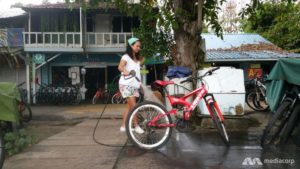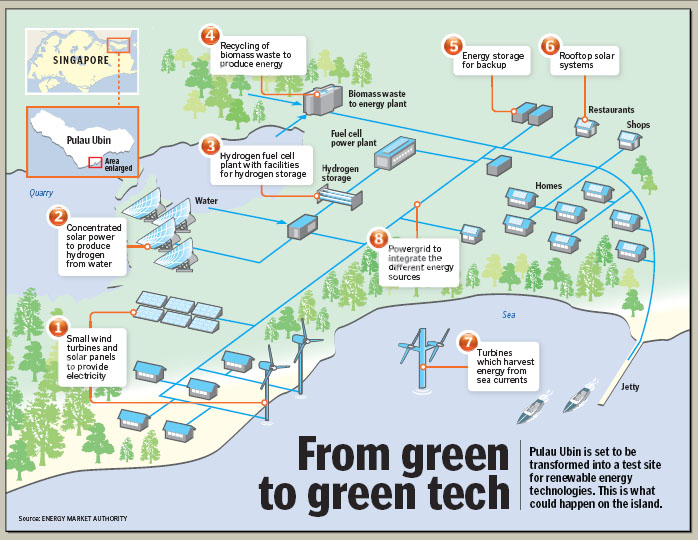
EMA is piloting a micro-grid test-bed at the jetty area of Pulau Ubin, an island north-east of Singapore. This test-bed aims to assess the reliability of electricity supply within a micro-grid infrastructure using intermittent renewable energy sources such as solar photovoltaic (PV) technology.
Unlike conventional power generators, solar power is intermittent in nature as the amount of energy produced is dependent on weather conditions. This challenge needs to be carefully managed to ensure reliability of supply to consumers, especially when solar forms an increasing part of Singapore’s overall energy mix in future.

- Small wind turbines and solar panels to provide electricity
- Concentrated solar power to produce hydrogen from water
- Hydrogen fuel cell plant with facilities for hydrogen storage(Hydrogen storage)
- Recycling of biomass waste to produce energy(Biomass waste to energy plant)
- Energy storage for backup
- Roftop solar systemsRestaurants
- Turbines which harvest energy from sea currents
- Powergrid to integrate the different energy sources
Pulau Ubin is set to be transformed into a test site for renewable energy technologies. This is what could happen on the island.
Source: ENERGY MARKET AUTHORITY
Since October 2013, about 30 participants from around the jetty area have signed up to voluntarily take part in this test-bed. They include various businesses (e.g. restaurants and bicycle shops), telecommunications base stations, residential premises and government agencies.
Thanks to this test-bed, they have been enjoying a cheaper, cleaner and more reliable electricity supply from a micro-grid incorporating clean and renewable energy sources such as solar PV technology. In the past, residents and businesses at the jetty area of Pulau Ubin relied on their own diesel generators for their electricity needs.
The test-bed will also provide a platform for local companies and research institutions to develop and pilot energy-related technologies and solutions. This will help build local capabilities in the area of micro-grid design, energy management and energy storage. The test-bed will also showcase how such micro-grid technologies and solutions could be adopted for off-grid communities in the region.
The micro-grid was built by a local consortium comprising Daily Life Renewable Energy Pte Ltd (DLRE) and OKH Holdings Pte Ltd (OKH). The latter is a wholly-owned subsidiary of SGX mainboard-listed OKH Global Ltd.
Phase Two
Singapore recently kicked off the second phase of the Pulau Ubin Micro-Grid project. Phase 2 of the test-bed will leverage the Phase 1 micro-grid infrastructure as a platform for companies and research organisations to develop and pilot energy-related technologies. EMA launched a Request-for-Proposal (RFP) for technologies in areas such as energy analytics, energy storage and grid asset management, and awarded two projects in 2015.
Phase Two will look at at how the energy can be better stored. Currently, lead batteries are used as they are a reliable option. But one company is testing a battery which will generate a smaller carbon footprint.
Three different types of batteries – Sodium-ion, Lithium-ion and Zinc–air – will be tested. ATEN said it is looking to pinpoint one that will better withstand Singapore's humidity and with a higher efficiency rate.
By mid-2016, all enhancements to the micro-grid will be made and a review of the results of Phase Two is expected by end 2017. (Source: Channel NewsAsia)